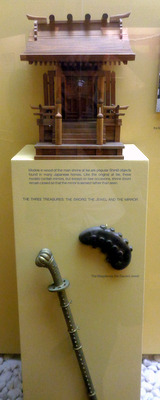The Imperial Regalia, or Three Sacred Treasures, are three sacred objects associated with the sun goddess Amaterasu and with the Imperial family, which were used in Imperial accession ceremonies since ancient times. They consist of the Sacred Sword Kusanagi no tsurugi, the Sacred Mirror Yata no kagami, and the Sacred Jewel Yasakani no magatama. Since ancient times, the Sword has been held at Atsuta Shrine in Nagoya,[1] the Mirror at Ise Shrine, and the Jewel at the Imperial Palace.
The Sword is believed to have been the earliest to be associated with the legitimacy of rulership, and to be used in imperial accession ceremonies, as early as the 6th century, if not earlier. Sixth century records of imperial accession ceremonies mention the Mirror as well. Both of these, but not the Sacred Jewel, appear in descriptions of accession ceremonies in the Taihô Code of 703; the Jewel does appear, however, in the Kojiki, which dates to 712. It has been suggested that this was due to opposition up through 703 by the Inbe clan or another clan of ritual specialists, and the rise of power of the Nakatomi clan in the 700s or 710s, who then altered the rituals to include the Jewel.
Following this change, accession rituals then regularly featured the Court's chief ritual specialist handing replicas of the Sword and Mirror, and supposedly the genuine Jewel (not a replica) to the new emperor as part of a symbolic transfer of power and legitimacy to him.
These accession rituals were disrupted in the 1460s-1470s by the Ônin War, and may have been performed in their full and proper form only sporadically through the remainder of the Sengoku period, and into the Edo period. Scholars have suggested that Shinto in the first half of the Edo period was more localized, its "national" significance diminished, and so for this reason among others, many state rituals came to be performed only sporadically by the Imperial court.
In the Meiji period, the Meiji government (and in particular the Ministry of Rites, or Jingikan) reinvented the accession ceremonies, as well as a great deal of other Imperial rituals and ceremonies, placing renewed emphasis on the importance of the three imperial regalia. A replica of the Sacred Sword was created, and was kept in close proximity to the Emperor.[2]
References
- Evelyn Rawski, Early Modern China and Northeast Asia: Cross-Border Perspectives, Cambridge University Press (2015), 118-119.
- ↑ It is widely suggested that the sword was lost in the 1185 Battle of Dan-no-ura, or at some other point, and has been merely a replica ever since then. The Imperial Household Agency has never confirmed these rumors, however.
- ↑ Takashi Fujitani, Splendid Monarchy, UC Press (1998), 258n49.
